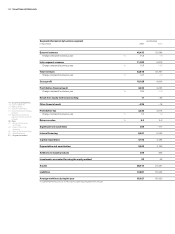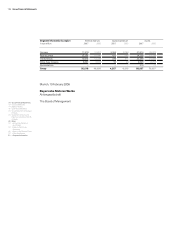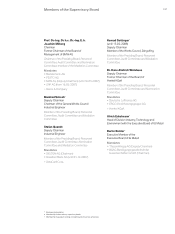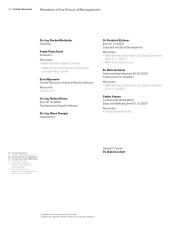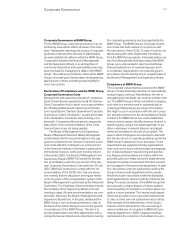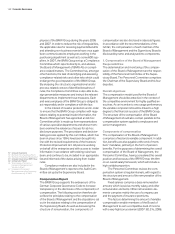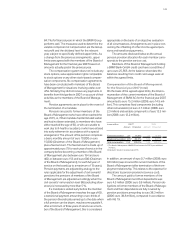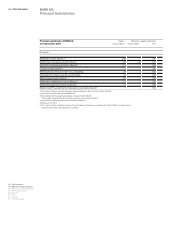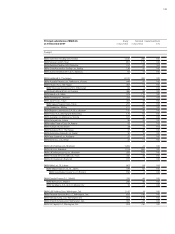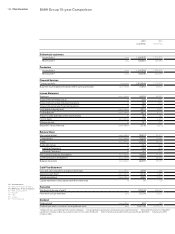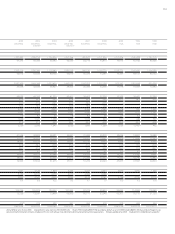BMW 2007 Annual Report Download - page 143
Download and view the complete annual report
Please find page 143 of the 2007 BMW annual report below. You can navigate through the pages in the report by either clicking on the pages listed below, or by using the keyword search tool below to find specific information within the annual report.141
Corporate Governance at BMW Group
For the BMW Group, corporate governance is an all-
embracing issue which affects all areas of the enter-
prise. Transparent reporting and a policy of corporate
governance aimed at the interests of stakeholders
are well-established traditions within the BMW Group.
Cooperation between the Board of Management
and the Supervisory Board, in an atmosphere of
commonly shared trust and responsibility, have long
been the basis for managing the affairs of the BMW
Group. The underlying corporate culture at the BMW
Group is
founded upon the principles
of transparency,
placing trust in others and taking responsibility for
one’s own actions.
Declaration of Compliance and the BMW Group
Corporate Governance Code
Management and supervisory boards of companies
listed in Germany are required by law (§ 161 German
Stock Corporation Act) to report once a year whether
the officially published and relevant recommenda-
tions issued by the German Government Corporate
Governance Code Commission, as valid at the date
of the declaration, have been, and are being, com-
plied with. Companies affected are also required to
state which of the recommendations of the Code
have not been or are not being applied.
The Board of Management and Supervisory
Board of Bayerische Motoren Werke Aktiengesell-
schaft believe that the recommendations and
sug-
gestions contained in the German Corporate Govern-
ance
Code (GCGC) contribute to an enhancement
of the financial markets in Germany, in particular for
international investors. At the joint meeting held on
4 December 2007, the Board of Management and
Supervisory Board of BMW AG issued the Declara-
tion of Compliance with the new version of the Ger-
man Corporate Governance Code valid from 20 July
2007. BMW AG continues to comply with the rec-
ommendations of the GCGC with only one excep-
tion: namely, that the discussion and regular review
of the structure of the compensation system of the
Board of Management is performed by the Personnel
Committee. The Chairman of that committee informs
the members of the Supervisory Board at its next
meeting in detail. All other recommendations are com-
plied
with. Moreover, the Board of Management and
Supervisory Board have, in the past, developed the
BMW Group’s own corporate governance code on
the basis of the GCGC taking account of the specific
circumstances of the BMW Group. The aim is to
provide shareholders and other stakeholders with a
comprehensive and stand-alone document covering
the corporate governance practices applied by the
BMW Group. The BMW Group’s Corporate Govern-
ance Code has been revised in conjunction with
the new version of the GCGC. A copy of it can be ob-
tained, along with other shareholder information,
from the BMW Group website. Interested parties can
also find other general information about the BMW
Group, up-to-date analysts’ reports and all Group
financial publications at www.bmwgroup.com/ir.
A coordinator responsible for all corporate govern-
ance issues reports directly and on a regular basis to
the Board of Management and Supervisory Board.
Compliance at BMW Group
The corporate culture that has evolved at the BMW
Group is characterised by clear lines of responsibility,
mutual respect and trust. Nevertheless, the risk of
wrongdoing by individuals can never be entirely ruled
out. The BMW Group is firmly committed to keeping
such risks to a minimum and to systematically un-
covering and following up any cases of corruption
that might occur. In accordance with the anti-corrup-
tion principle enshrined in the United Nations Global
Compact, the BMW Group has a well-established
internal control system, the effectiveness of which is
tested regularly using a risk-based approach. In ad-
dition, employees in relevant divisions and depart-
ments are sensitised to the risk of corruption. The
ways in which employees are expected to deal with
this risk are set out in corporate guidelines and in the
BMW Group’s stated set of core principles. Those
requirements are supplemented by organisational
rules such as the dual control principle and segrega-
tion of duties between requisitioning and purchas-
ing. Regular and mandatory job rotation within the
purchasing function helps to prevent dependencies
between the parties involved and therefore receives
the full support of the personnel department. In addi-
tion, all business units are subjected to audit by the
Group’s internal audit department within a prede-
fined time scale in accordance with the Standards
promulgated by the German Institute of Internal Au-
diting. Processes and areas of the BMW Group that
are exposed to a higher degree of risk are audited
more frequently, for example in countries where cor-
ruption is more prevalent. The internal audit depart-
ment also provides tools to specialist departments
to carry out their own risk assessment and controls.
One example of the effectiveness of the Group’s
internal control mechanisms is the uncovering of
various incidences of corruption in BMW AG’s pur-
chasing department in 2005. Legal proceedings
culminated in the conviction of a number of ex-em-
Corporate Governance



